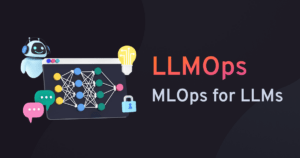Deploying generative AI comes with its challenges. Some of the main risks include potential inaccuracies, concerns over privacy and security, and a notable absence of transparency in how these AI systems operate. A new AI field known as LLMOps, short for Large Language Model Operations, has emerged, in response to these challenges.
LLMOps encompasses critical tasks such as deployment, scaling, monitoring, and regular updates of these models. In this article, we explore definitions and the relation between LLMOPs and MLOps, also, How does it function?
What is LLMOps?
LLMOps, or Large Language Model Operations, refers to a specialized set of tools and practices designed for managing the lifecycle of applications powered by large language models. This includes the development, deployment, and maintenance of such applications, ensuring they perform optimally throughout their use.
The need for LLMOps emerged with the advent of language models, such as OpenAI’s ChatGPT. These models present unique challenges due to their significant size, complexity, and the specialized tasks they perform. Therefore, a distinct operational framework was necessary to address these new requirements effectively.
LLMOps provides an array of customized tools and methodologies aimed at efficiently managing LLMs. This ensures that the capabilities of large language models are fully leveraged, contributing to innovation and development within the AI sector.
As the field of artificial intelligence continues to evolve, LLMOps empowers organizations to capitalize on LLM-driven applications. It facilitates the smooth selection of foundational models, alongside the proficient management of their deployment and ongoing maintenance. Consequently, LLMOps has become indispensable for organizations striving to remain competitive in the dynamic AI landscape.
LLMOps as MLOps for Large Language Models
LLMOps can be seen as an extension of MLOps, designed to cater specifically to the operational needs of large language models. It adapts the foundational principles of MLOps—such as continuous integration, delivery, and monitoring—to the scale and complexity of LLMs.
This adaptation is crucial, as the operational challenges posed by LLMs, such as deployment speed, resource allocation, and ongoing optimization, demand a more robust framework that traditional MLOps might not fully address. This article will delve into the differences between LLMOps and MLOps in the following sections.

The Core Components of LLMOps
Practically, there are three core components in LLMOps: selecting appropriate foundation models, adapting pre-trained LLMs, and managing the lifecycle of these models, which includes rigorous evaluation of model outputs using metrics such as accuracy, precision, recall, F1-score, and avoiding AI mistakes or errors, among others. These components guide organizations in effectively deploying and maintaining AI product development within a feedback loop.
1- Selection of a Foundation Model
Selecting the right foundation model is a critical step in the LLMOps’ development process. Models such as GPT-3 and LLaMa, created by Meta AI or OpenAI, serve as the starting point for various downstream tasks. Since model training from scratch is cost-prohibitive and time-consuming, fine-tuning existing models is more practical.
The choice between proprietary and open-source models depends on factors like performance, cost, ease of use, and adaptability of AI models. To aid decision-making, consider the following table showcasing popular LLMs and their key features:
2- Adapting Pre-Trained Models
Once an appropriate foundation model is selected, adapting pre-trained models for specific applications becomes crucial. This involves fine-tuning the selected pre trained model using techniques like prompt engineering and adding external data for context. Managing model accuracy and preventing hallucinations are key challenges addressed through these techniques. The significance of model weights in the development and deployment of large language models cannot be overstated, as they are crucial for fine-tuning and significantly improving the performance of language models on specific tasks within the LLMOps domain.
Tools such as LangChain, HoneyHive, and vector databases support the adaptation process by providing methods for improving interaction with LLMs and managing input prompts. These tools enable developers to accomplish tasks such as:
- Optimizing prompt engineering for better response generation
- Using external or custom data sources to enhance LLM context
- Monitoring and analyzing model predictions to prevent hallucinations
3- Managing LLM Lifecycle with LLMOps
The lifecycle of large language models through LLMOps includes monitoring models, and LLM evaluation performance using LLM strategies like A/B testing and tracking prompt responses. Building on this foundation, Large Language Model Operations also emphasize the importance of real-time data gathering and model observability in production.
This involves closely monitoring prompts, completions, and their nuances to ensure that the AI systems maintain their efficacy. To achieve effective LLM lifecycle management, consider incorporating the following best practices:
- Implement iterative model development processes to improve model performance
- Monitor model drift and bias to maintain optimal performance
- Use observability tools and techniques for real-time insight into model interactions
- Deploy continuous integration and delivery pipelines for efficient updates and management

Infrastructure of LLMOps Tools
Building the infrastructure for large language models (LLMs) demands comprehensive knowledge and the right set of tools. LLM Operations offers specialized methodologies and framework adaptations to provide the capabilities required for the fine-tuning and deployment of LLMs.
With LLMOps, teams of data scientists can better understand and manage the necessary computational resources, such as parallel GPU machines and large dataset handling, ultimately enabling organizations to harness the full power of LLMs.
Moreover, the LLM operations infrastructure encompasses a wide range of tools and platforms for the entire process, ranging from prompt engineering to retrieving contextually relevant information. These tools aid in supporting multiple layers of the LLM ecosystem and maintaining its smooth functioning.
- Foundational models for fine-tuning and deployment
- Hardware and software resources (GPU machines, parallel computing)
- Tools for prompt engineering and fine-tuning (LangChain, HoneyHive)
- Access to vector databases and retrieval systems
- Data storage and management solutions
- Monitoring and observability tools
As more organizations adopt LLMs and move their AI applications from proof of concept to production, developing a robust LLMOps infrastructure becomes crucial to remain competitive and innovative in the ever-evolving AI landscape.
Impact Assessment: How LLMOps is Changing the AI Application Landscape
LLMOps is revolutionizing the AI application landscape by addressing the unique challenges posed by implementing large language models (LLMs) for various purposes. In this section, we explore the significant role LLM operations play in scaling AI applications and its influence on analytics and optimization in the AI industry.
The Role of LLMOps in Scaling AI Applications
LLMOps plays a crucial role in scaling AI applications by offering specialized operational capabilities for LLMs. By addressing the complexities involved in developing, deploying, and maintaining AI applications powered by LLMs, facilitates more effective scaling of AI services.
Organizations employing LLMOps can embrace robust prompt management systems, LLM chaining, and observability techniques, ultimately transforming the way AI is applied across various sectors.
- Streamlining development processes using fine-tuning and prompt engineering.
- Optimizing deployment strategies for LLMs according to application specifics.
- Ensuring efficient maintenance and management of LLM-powered applications.
- Maximizing performance by harnessing the full potential of large language models.

Benefits of LLMOps
Integrating LLMOps offers significant advantages for organizations, streamlining the development and management of AI-driven products. Here’s how LLMOps propels organizations ahead:
– Efficiency in AI Development
LLMOps enhances the efficiency of developing AI products, allowing for quicker innovation and deployment.
– Performance Optimization
It ensures AI applications perform optimally, leveraging the full capabilities of LLMs.
– Lifecycle Management
Organizations gain enhanced control and transparency over the lifecycle of LLMs, from development to deployment and maintenance.
– Alignment with Industry Trends
Adopting LLMOps aligns organizations with the latest trends in AI and machine learning, ensuring they remain at the forefront of technological advancements.
– Transformative Impact and Industry Adoption
The emergence of LLMs has transformed the AI landscape, making advanced machine learning accessible and user-friendly. This shift has necessitated the rise of LLMOps, a specialized practice for managing these complex models effectively. By adopting LLMOps, organizations can:
- Navigate the complexities of LLM-powered applications with ease.
- Enhance the accessibility and functionality of machine learning, turning intricate AI operations into simple, intuitive processes.
- Achieve a higher return on investment (ROI) and improved performance in AI-driven initiatives.
LLMOps vs MLOps
LLMOps, or Large Language Model Operations, extend beyond traditional MLOps by focusing on the specific needs of large language models like GPT. It encompasses developing, deploying, and maintaining models, addressing challenges like fine-tuning LLMs, data annotation, and infrastructure scaling, unique to the sheer size and complexity of LLMs.
The steps involved in building an LLM-powered application, from development to evaluation, are markedly different from those in building applications with classical ML models, particularly in how LLMs are evaluated against traditional ML models, highlighting the distinct challenges and best practices in managing their lifecycle.
Although it encapsulates the concept of MLOps, LLMOps specializes in addressing the intricacies of LLMs, aiming to streamline and optimize the operations of these large-scale models, which are noticeably different from classical machine learning models.
The Role of LLMOps in Large Language Model Deployment
LLMOps is crucial to truly harness the potential of large language models in production environments. It provides a specialized framework for the model development, deployment, and maintenance of LLM-powered applications, enabling organizations to effectively manage and optimize the performance of these complex AI systems.
LLMs, such as GPT-3, GPT-4, and AiseraGPT have created a shift in the field of artificial intelligence. With billions of parameters, these LLMs are trained on massive datasets and utilized for various complex applications. Their scale and capabilities demand a specialized focus, leading to the emergence and adoption of LLMOps to manage their unique challenges effectively.
The need for effective Large Language Model Operations is primarily driven by the distinctive aspects of LLMs as compared to classical machine learning models. Unlike their simpler counterparts, LLMs often involve adapting pre-trained models to specific tasks, like creating a domain-specific LLM. This process of fine-tuning foundation models to suit downstream tasks requires innovative approaches and a diverse set of tools and methodologies beyond what traditional MLOps has to offer.
Some of the primary reasons for the growing importance of LLMOps are:
- The size and capacity of LLMs: With billions of parameters, LLMs require a more robust infrastructure and specialized techniques to handle their scale and complexity.
- Variety of applications: LLMs have far-reaching applications, ranging from natural language processing to advanced analytics. The sheer variety of potential use cases increases the demand for specialized treatment.
- Continuous model evolution: As the field of AI continues to advance rapidly, LLMs require frequent updates and continual model training, necessitating a greater focus on efficient operations and maintenance.
Strategic Importance of LLMOps
A key factor for LLMOps is team dynamics. This requires effective collaboration between DevOps, IT professionals, data scientists, subject matter experts, and analysts. Collaboration across teams, from data engineering to data science to ML engineering, is crucial, highlighted by the experience of professionals like a Senior Solutions Architect who previously led Data Science at Amazon’s EU Customer Service.
This means establishing well-defined plans for data preparation, prompt engineering, fine-tuning, deployment, and monitoring. However, the framework should also be flexible enough to allow for innovative approaches and experimentation.
Effective LLMOps also require a shift in mindset from traditional software development, which typically involves structured inputs and outputs, to a more variable approach. For instance, prompting a model is not just a technical procedure but a blend of art and science. This reflects the less predictable nature of these applications.
As for evaluating an LLMOps technology platform, it can be difficult too. A major reason is these systems are relatively new in the tech landscape. But there are some considerations to keep in mind. First, it’s important to choose a platform capable of handling large data volumes and that integrates with vector databases. The data pipeline should also feature an advanced versioning system, which is crucial for analyzing and monitoring the prompts and responses of the LLMs.
Next, a system should have standard performance metrics typically used for Generative AI models. Common examples include the Bilingual Evaluation Understudy (BLEU) and Recall-Oriented Understudy for Gisting Evaluation (ROUGE).
LLMOps is Critical for Generative AI Accuracy
In deploying generative AI applications, it’s common to use a variety of models. For instance, an enterprise might include its proprietary LLMs, along with third-party systems, specifically for the ones with security concerns like generative AI in banking, or generative AI in insurance.
For these deployments, there comes the need for intricate prompts and fine-tuning as well as Retrieval Augmented Generation (RAG) for handling extensive documents. This requires the adoption of new technologies like vector databases. Moreover, the fine-tuning and RAG processes require the use of GPUs (Graphics Processing Units), which are both costly and currently in limited supply.
A critical aspect of refining these models involves minimizing costs and computational demands, such as by reducing batch sizes. Even minor adjustments in this area can lead to significant impacts.
Piecing all these elements together is difficult, especially given the relative immaturity of the tooling systems involved. As a result, enterprises find themselves needing to depend on data scientists, a talent pool that is not only costly but also challenging to attract.
Another issue arises from the inherent unpredictability of generative AI models. This stems from the underlying transformer models, which employ neural networks that operate on complex probability algorithms. It’s this advanced approach that enables LLMs to generate responses that appear remarkably human-like.
But this means that testing these models can be challenging. For enterprises, this poses the potential harm of generating inaccurate, inappropriate, or off-target responses. This can be particularly harmful when there are interactions with customers.
Analytics and Optimization in the Era of LLMOps
LLMOps places considerable emphasis on analytics and optimization, enabling continuous improvement in the performance of LLM-powered applications. The introduction of LLM operation tools and best practices helps organizations track and evaluate model performance, monitor drift and bias, and implement changes as needed to maintain optimal performance.
This focus on data collection, analytics, and optimization is fundamental as LLMOps shapes the present and future states of AI applications, emphasizing the importance of data-driven decision-making in the AI application landscape.
| Analytics | Optimization |
| Real-time monitoring of LLM performance | Effective prompt management systems |
| Identifying and addressing drift and bias | Streamlining deployment strategies |
| Data-driven decision-making | Implementing targeted changes to improve application performance |
Future of LLMOps and Industry Impact
As the AI tech ecosystem evolves rapidly, Large Language Model Operations are expected to play a pivotal role in shaping the future of AI technology. Ongoing innovations in LLMOps tools and methodologies demonstrate the sector’s commitment to making generative AI more accessible and applicable to a wide array of business challenges.
With advancements in prompt engineering and foundational model management, there is much to anticipate in LLMOps’s future developments.
Predictions for LLMOps Tools and Methodologies
Moving forward, constant tool and methodology advancements are likely to dominate predictions for LLMOps. Organizations can expect new developments in crucial aspects of LLMOps, such as monitoring, observability, data preparation, and the streamlining of LLMs.
These enhancements aim to facilitate better performance and user satisfaction for all stakeholders in the AI tech ecosystem.
|
Area of Advancement |
Potential Developments |
| Prompt Engineering | More precise and context-aware prompting techniques |
| Model Monitoring and Observability | Real-time performance tracking and rapid response to model drift or biases |
| Infrastructure and Optimization | Improved computational efficiency and resource management for large-scale AI systems |
| Integration within MLOps | Enhanced synergies and collaboration between LLMOps and broader MLOps practices |
Conclusion
As the modern AI paradigm continues to evolve, LLMOps has emerged as a crucial foundation for managing the development, deployment, and maintenance of Enterprise LLM powered applications. It offers a set of specialized practices and tools tailored to handle the scale and complexity of large language models, thereby optimizing their operational efficiency and driving innovation in AI technology.
Some key takeaways on Large Language Model Operations include its specialized focus on LLMs, the importance of analytics, data management, and optimization in the era of LLMOps, and the transformative effects it has on the AI application landscape. By providing insights into the nuances of LLM management, LLMOps shape the future of AI operations and business strategies, making it essential to embrace and adopt for business growth.
The strategic importance of adopting LLMOps for business growth cannot be understated. By implementing LLMOps practices, enterprises can leverage the full potential of large language models to create sophisticated, AI-driven products and services.
This not only delivers superior customer experiences but also drives success in the AI-driven market, allowing organizations to maintain a competitive edge in the rapidly evolving field of AI. Book a free AI demo today!

